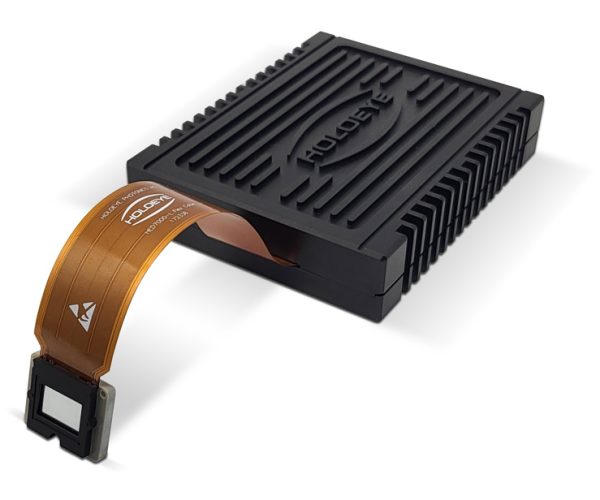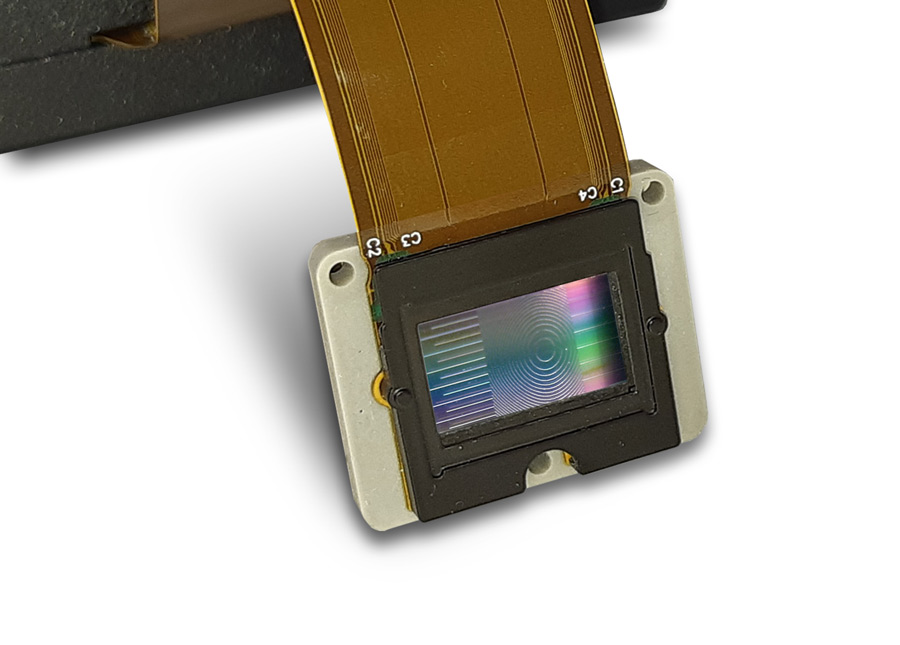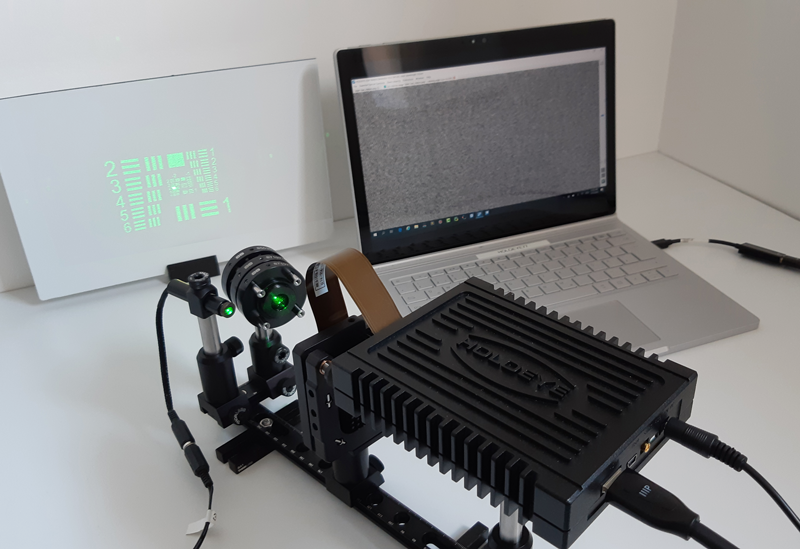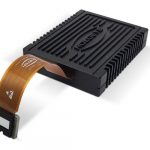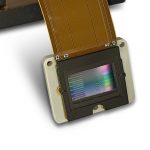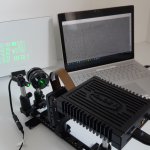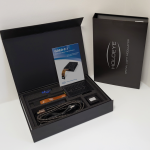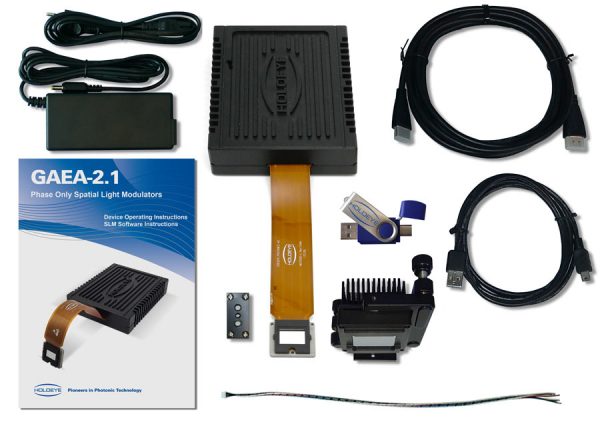The Highest Resolution SLM on the market
The HOLOEYE GAEA-2.1 Spatial Light Modulator (SLM) redefines high-resolution light modulation, offering a sophisticated solution for advanced optical applications. This phase-only LCOS (Liquid Crystal on Silicon) microdisplay sets a new standard with its exceptional pixel density and versatile functionality.
The GAEA-2.1 Spatial Light Modulator (SLM) is a phase-only device featuring a driver unit with an HDMI input. Its core is a Liquid Crystal on Silicon (LCOS) microdisplay, offering a 10-megapixel (4K) resolution (up to 4160 x 2464 pixels). Each pixel measures 3.74 µm, resulting in a 0.7-inch active display diagonal.
This GAEA-2.1 SLM functions as a plug-and-play phase modulator. Users can project phase functions onto it by connecting it to a standard graphics card as an extended display. It supports 8-bit grayscale patterns, which translate to 8-bit phase levels. To operate, the graphics card must be HDMI-2 compatible and capable of outputting uncompressed visuals at a minimum resolution of 3840 x 2160 pixels.
Controlling the GAEA-2.1 is straightforward, thanks to the included Pattern Generator and SLM Slideshow Player software, or even standard image viewers. For developers, HOLOEYE also offers an SLM Display Software Development Kit (SDK) with APIs for various programming languages.
Multiple Versions Available

Multiple versions of the GAEA-2.1 SLM are available, each optimized for specific wavelength ranges:

Color Field Sequential (CFS) Operation
The GAEA-2.1 Spatial Light Modulator now supports Color Field Sequential (CFS) phase modulation, thanks to its updated firmware. This capability allows the driver to address bits within a single frame, achieving a rapid 180 Hz frame rate. For seamless integration, the SLMs are equipped with an RGB light source sync connector, perfect for synchronizing with RGB color-switchable laser sources. Specifically, the GAEA-2.1-CFS-159 version is fine-tuned for quick response times, making it ideal for computer-generated color holography.
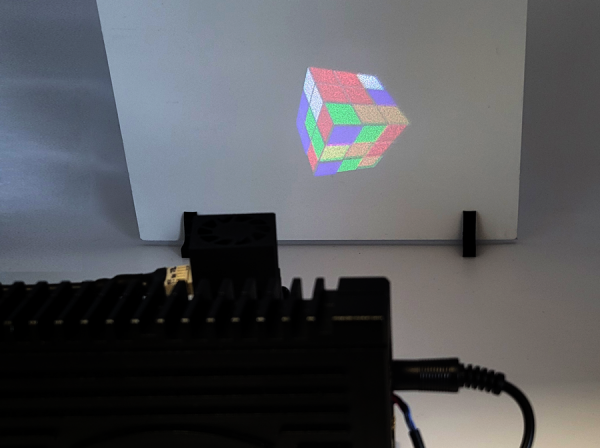
GAEA-2.1 Applications
- Digital Holography: Applied in augmented and virtual reality, metrology, quantum holography, and holographic and head-up displays.
- Microscopy: Used in two-photon microscopy, laser-scanning microscopy, absorption microscopy, light sheet microscopy, and phase contrast imaging.
- Wavefront Correction and Processing: Employed in microscopy and general imaging applications.
- Holographic Optical Tweezers: Facilitate cell sorting, drug development, and micro rotator functionalities.
- Beam Shaping with Structured Light: Integrated into 3D scanners, various imaging technologies, free space communication, microscopy, holographic optical tweezers, and material processing.
- Higher Order Generation: Applicable in microscopy, optical trapping, free space communication, and imaging.
- Material Processing: Utilized for parallel laser drilling, selective laser melting, laser marking, and the generation of complex photonic lattices.
- Wavelength Selective Switching and Telecommunication: Primarily used within telecommunication systems.
- Mask-less and Holography Lithography: Employed in photo semiconductor device development, micro ID numbering, MEMS, bio-life science complex chemistry, optical communication, and projection in automotive lighting.
- Polarization Generation: Beneficial for high-resolution imaging, confocal microscopy, two-photon microscopy, second-harmonic generation microscopy, dark field imaging, microellipsometry, and optical communication
HOLOEYE Spatial Light Modulator Catalog
Publications Featuring GAEA-2.1
- Chlipala, M., Cruz, ML., Martinez-Carranza, J. et al. Wide-angle color holographic near eye display with full bandwidth frequency multiplexing. Sci Rep 15, 15221 (2025). https://doi.org/10.1038/s41598-025-98411-3
- Yuki Takemura, Hirohito Nishi, and Kyoji Matsushima “Denisyuk-type wavefront printer and its computational correction of aberration in optical system“, Proc. SPIE 13390, Practical Holography XXXIX: Displays, Materials, and Applications, 133900N (19 March 2025); https://doi.org/10.1117/12.3040432
- Zhenqi Xu, Junmin Leng, Ping Dai, and Chao Wang, “DSCCNet for high-quality 4K computer-generated holograms,” Opt. Express 33, 13733-13747 (2025)
- Zhenxing Dong, Yuye Ling, Yan Li, and Yikai Su “Motion Hologram: Jointly optimized hologram generation and motion planning for photorealistic 3D displays via reinforcement learning”, Proc. SPIE, (29 January 2025); https://doi.org/10.1126/sciadv.ads9876
- Riku Watanabe, Seok Kang, and Yuji Sakamoto, “Binocular holographic display with a wide viewing zone using eye-tracking and multiple reconstruction lights,” Appl. Opt. 64, 984-994 (2025)
- Haifa Fan, Qian Cao, Xin Liu, Andy Chong, and Qiwen Zhan “Perfect Spatiotemporal Optical Vortices“, arXiv:2501.11426 (20 January 2025); https://doi.org/10.48550/arXiv.2501.11426
Software
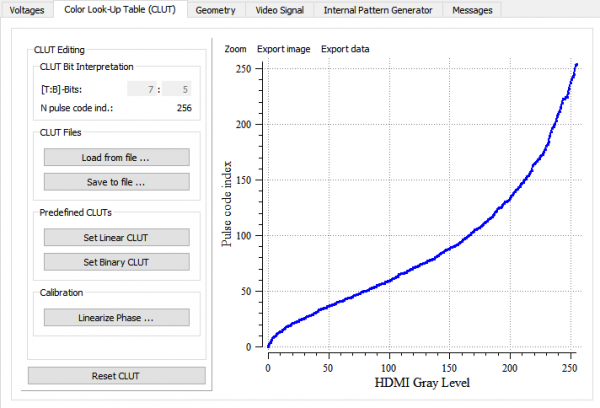
-
HOLOEYE’s GAEA 4K phase-only modulators are designed for straightforward integration, functioning like a standard external monitor via a graphics card’s HDMI interface. They require no special software or hardware to operate.
For advanced adjustments, the device includes a Graphical User Interface (GUI) Configuration Manager. This software connects via USB and allows users to modify geometric settings, brightness, contrast, and electro-optical response, including applying new gamma curves or digital drive schemes.
Additionally, HOLOEYE provides a SLM Pattern Generator software for:
- Creating computer-generated holograms (CGHs) from user-defined images.
- Generating SLM signals for fundamental optical functions such as lenses, gratings, axicons, and vortex functions.
- Combining CGHs with basic optical functions.
The device also comes with a SLM Slideshow Player software. For developers, an SLM Display SDK is available, offering APIs for direct image and data/phase array display on HOLOEYE Spatial Light Modulators. Supported programming environments include:
- National Instruments LabVIEW™ (8.6 and later)
- MathWorks MATLAB® (R2009b and later)
- Octave (5.2)
- Python™ (2.7 and 3.x)
- C or C++ compilers (e.g., Microsoft Visual C++ Compiler)

